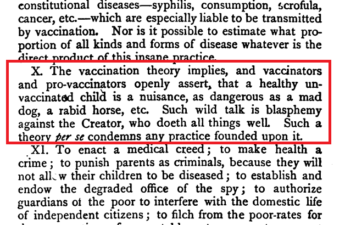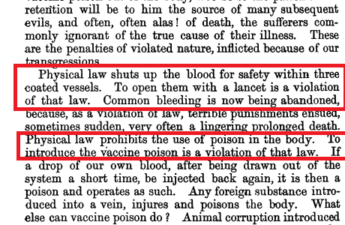
by Steve Halbrook
We have already showd that the very act of vaccination bypassing the initial immune responses (innate/cellular) for the secondary immune responses (adaptive/humoral) is self-defeating, as it bypasses the immune system’s primary detoxification mechanism – preventing a healthy recovery from vaccine ingredients.
However, aside from all of this, the bypassed initial immune response is also intended to control the secondary immune response. Thus whatever benefits the secondary immune response has or is said to have (backup defense against pathogens, antibody protection, etc.), absent initiation via the bypassed control mechanism, one must ask, how much, if anything, can the secondary immune system achieve?
This further renders vaccination self-defeating. The vaccinated immune system is effectively left without proper defense and proper control – like a military unit with no weapons or officers.
Consider the following — keeping in mind that innate immunity is the part of the immune system that vaccination bypasses.
From Advances in Immunology:
It is now universally recognized that innate instruction of adaptive immunity is a critical step that controls the activation, types, and duration of the adaptive immune response. Innate instruction occurs initially during the interaction between antigen-presenting cells (APCs) and T cells.
Dominik Schenten and Ruslan Medzhitov, “The Control of Adaptive Immune Responses by the Innate Immune System,” Advances in Immunology, Volume 109, 2011, Pages 87-124 (Available online 11 May 2011). Retrieved March 22, 2024, from https://www.sciencedirect.com/science/article/abs/pii/B9780123876645000030
From Mol Cells:
Recent studies have focused on innate immunity as the first line of host defense and its role in inducing adaptive immunity …
Effective response to and control of microbial infection seems to require several levels of interactions between the innate and adaptive immune systems. Recent studies suggest that the induction of co-stimulatory molecules and secretion of cytokines and chemokines by the cells of the innate immune system significantly affect the quality and quantities of T and B cells of the adaptive immune system.
Sang-Moo Kang and Richard W. Compans, “Host Responses from Innate to Adaptive Immunity after Vaccination: Molecular and Cellular Events,” in Mol Cells, 2009 Jan 31; 27(1): 5–14. Retrieved March 22, 2024, from https://www.ncbi.nlm.nih.gov/pmc/articles/mid/NIHMS987138
From Immunobiology: The Immune System in Health and Disease:
The macrophages and neutrophils of the innate immune system provide a first line of defense against many common microorganisms and are essential for the control of common bacterial infections. However, they cannot always eliminate infectious organisms, and there are some pathogens that they cannot recognize. The lymphocytes of the adaptive immune system … provide a more versatile means of defense which, in addition, provides increased protection against subsequent reinfection with the same pathogen. The cells of the innate immune system, however, play a crucial part in the initiation and subsequent direction of adaptive immune responses, as well as participating in the removal of pathogens that have been targeted by an adaptive immune response. Moreover, because there is a delay of 4–7 days before the initial adaptive immune response takes effect, the innate immune response has a critical role in controlling infections during this period. …
The innate immune response makes a crucial contribution to the activation of adaptive immunity. The inflammatory response increases the flow of lymph containing antigen and antigen-bearing cells into lymphoid tissue, while complement fragments on microbial surfaces and induced changes in cells that have taken up microorganisms provide signals that synergize in activating lymphocytes whose receptors bind to specific microbial antigens. Macrophages that have phagocytosed bacteria and become activated can also activate T lymphocytes.
Janeway CA Jr, Travers P, Walport M, et al., “Principles of innate and adaptive immunity,” in Immunobiology: The Immune System in Health and Disease, 5th edition (New York: Garland Science, 2001). Retrieved March 22, 2024, from https://www.ncbi.nlm.nih.gov/books/NBK27090
Can vaccination effectively stimulate the primary immune response from the back door?
But can vaccination properly control the immune response if in fact it has its own way of accessing the primary (innate) immune response?
The vaccinators will argue that vaccination does in fact activate the primary immune response, even though it is intially bypassed in injection. Thus, Mol Cells, as we previously cited, states,
Live bacterial or viral vaccines efficiently activate the innate immune system, presumably through pathogen-associated signals allowing their recognition by PRRs.
However, there are several challenges to this view. First, are those who assert such deceived or even lying? Vaccination is a matter of trust, and the vaccinators have failed in this regard throughout the history of vaccination. Fool me twice, shame on me. The notion that vaccines are safe and effective has been disproved again and again.
Moreover, even if vaccination has a way to trigger the primary (innate) immune response from the back door, how effectively does it? Does it do it completely, or partially? Note that natural antibodies and vaccine-induced antibodies are not the same. If not the same — with natural antibodies being superior — then how can the triggering of the primary immune response said to be caused by vaccination be effective?
The fact that vaccination triggers an immune response from a different route (injection) than is done in the normal way (via the mouth or nose) is telling. As is the use of poisons (“adjuvants”) in vaccines to foster an innate immune response, which natural immune stimulation does not require. The fact that vaccination violates God’s natural design in these regards should give us pause in thinking that we can stimulate a immune process as effectively, or even at all, in our own way.
Indeed, while we are told that backdoor-triggering of the primary (innate) immune response can be achieved via vaccination, why then does vaccination cause an unhealthy imbalance in the immune system (favoring the secondary immune response)?
And, of course, we know the tree by the fruit. Vaccination cannot stimulate the immune system in a healthy way, as we see from its dark history. And certainly today, vaccines — as it concerns those pushing them at the top — are a tool to maim and murder for population control (this has become most clear with the COVID-19 jabs). Thus those at the top of the vaccine pyramid wouldn’t want a vaccine that effectively stimulates the primary immune system, even if they could.
Interestingly, pro-vaccine authors write the following in Clinical & Translational Immunology (2016); it does not inspire one with confidence that vaccines have “arrived” regarding stimulating a primary (innate) immune response:
As stimulating innate immune responses is a prerequisite for generating adaptive vaccine responses, co-formulation with adjuvants is needed for many subunit vaccines. How adjuvants work is not fully understood; however, much evidence suggests that they activate innate immune responses. …
However, the series of innate immune responses occurring between the time of vaccine delivery and induction of the measurable adaptive immunity remain largely unknown. This review therefore evolves around the limited current knowledge about the early local innate immune responses in vivo in the muscle after injection with adjuvants used in approved human vaccines. …
[Adjuvants] may therefore stimulate different features of innate immunity. …
With a more in-depth knowledge of the immune mechanisms involved in generating vaccine responses, we would be better positioned to rationally design new vaccines.
Liang, F. and Loré, K. (2016), Local innate immune responses in the vaccine adjuvant-injected muscle. Clin Trans Immunol, 5: e74. https://doi.org/10.1038/cti.2016.19
The problem in a nutshell
Vaccination, then, subverts and nullifies a proper immune process by 1) bypassing half your immune system and 2) leaving the other half without its normal control mechanism. It is like leaving a ship to sail for itself; or, to use military terms (given the role of the immune system in combating toxins), an officer abandoning the battle, leaving his troops in disarray in the heat of an enemy attack.
Shawn Siegel observes,
The body expects to see the vast majority of exposures to potential pathogens on the surface of the skin or in the mucosal membranes of the nose, the mouth, the throat, the respiratory system, the gastrointestinal system — in some cases, the urogenital system. It is in those locations that critical cellular decisions (metaphorically speaking) are made. In the vast majority of instances of exposure to potential pathogens, in each of our lives, that innate reaction that takes place — again, either on the surface of the skin, or in the mucosal membranes of the body — successfully either eliminates, or disarms, if you will, those potential pathogens. The first decision made is not in the bloodstream. The events that do take place ultimately in the bloodstream … the Th2 arm of immune reaction, do not occur after natural exposure unless they are initiated by the Th1 reaction — the innate reaction. And studies have told us — not only does that innate reaction initiate the adaptive reaction, if you will, but it controls it as well. So when you bypass that full innate reaction, as does vaccination because of the injection, you are bypassing the control mechanism. It is like you are removing the captain from the ship.
Shawn Siegel, “The Vaccine Myth: An Issue of Trust: December 31, 2017” (Logos Radio Network). Retrieved March 21, 2024, from http://mp3.logosradionetwork.com/VAX/16k/VAX_2017-12-31_16k.mp3
Sure, the immune system is very complex; at best, maybe emergency backup processes will come into play to combat injected poisons. But it is not something you want to bank on. Normal and emergency processes in this case are two different levels of safety and efficacy completely; to give an analogy, consider the difference between a normal functioning heart, and a heart requiring a pacemaker. You don’t want the latter if you can avoid it.
(Good nutrition and especially intravenous Vitamin C may play a role in combating injected vaccine poisons, which we plan to discuss in the future.)
In bypassing the natural, orderly processes of the immune system, you are, by injection of foreign substances via vaccination, pushing your immune system and body’s defenses into a corner — maybe even to the brink — and the results can be disastrous.
Consider how your immune system reacts in the dangerous conditions of encephalitis (brain inflammation) and anaphylactic shock — both of which vaccines are notorious for inducing (see here and here).
On inflammation in general and encephalitis in particular:
Inflammation is your body’s response to an illness, injury or something that doesn’t belong in your body (like germs or toxic chemicals). Inflammation is a normal and important process that allows your body to heal. … But inflammation can harm you if it occurs in healthy tissues or goes on for too long.
Cleveland Clinic, Inflammation (Last reviewed 03/22/2024).
Retrieved April 11, 2024, from
https://my.clevelandclinic.org/health/symptoms/21660-inflammation
Encephalitis (pronounced en-sef-uh-lie-tis) is inflammation of your brain tissue. It can be very serious and may cause personality changes, seizures, weakness, and other symptoms, depending on the part of your brain affected. … In severe cases, [it causes] loss of consciousness (coma) and death.
Marijke Vroomen Durning and Lori M. King, Understanding Encephalitis: The Basics (WebMD, February 28, 2024). Retrieved April 11, 2024, from https://www.webmd.com/a-to-z-guides/understanding-encephalitis-basics
On anaphylaxis:
Anaphylaxis is a severe, life-threatening allergic reaction. It can happen seconds or minutes after you’ve been exposed to something you’re allergic to. Peanuts or bee stings are examples. In anaphylaxis, the immune system releases a flood of chemicals that can cause the body to go into shock. Blood pressure drops suddenly, and the airways narrow, blocking your breathing. The pulse may be fast and weak, and you may have a skin rash. You may also get nauseous and vomit. … If it isn’t treated right away, it can be deadly.
Mayo Clinic, Anaphylaxis (October 2, 2021). Retrieved April 3, 2024, from https://www.mayoclinic.org/diseases-conditions/anaphylaxis/symptoms-causes/syc-20351468
And so one might say that vaccination divides and conquers your immune system by, metaphorically, decapitating the head (in bypassing the initial immune response) and leaving the body (secondary immune response) to fend for itself in dealing with toxic substances in the name of creating immunity.
The question then becomes not how effectively a vaccine protects your health, but how effectively it destroys it.
For the sake of health, resist vaccination.
Christians, remember:
Or do you not know that your body is a temple of the Holy Spirit within you, whom you have from God? You are not your own, for you were bought with a price. So glorify God in your body. (1 Corinthians 6:19-20)
If you find this site helpful, please consider supporting our work.


